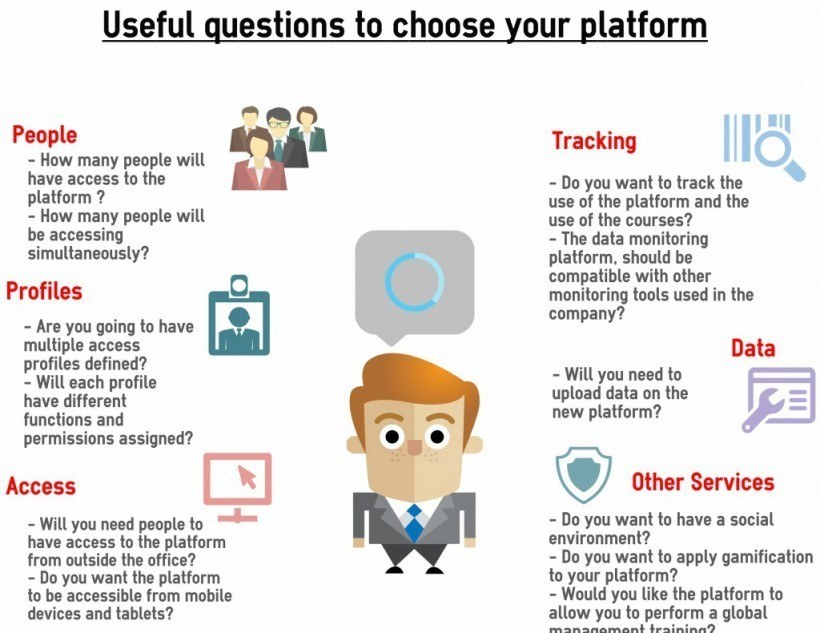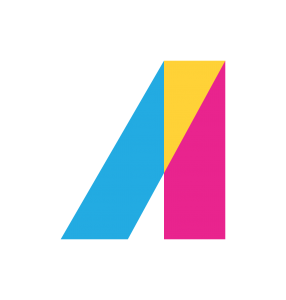What You Need To Ask Before You Choose An Online Training Platform
If you are looking for an online training platform for your company, you might first define exactly what it will be used for, who will use it, when, and under what conditions. We recommend that you keep working meetings with various departments of your company in defining these issues.
As an initial guide, we invite you to try to respond to a series of basic and important questions to help you determine which online training platform best suits your needs:
Sponsored content - article continues below
Trending Learning Management Systems (LMS)
1. How many people do you want to be on the platform? How many people will be accessed simultaneously?
This question will affect servers you employ to host your online training platform. The higher the number of students who will access simultaneously, the bigger the capacity you should hire.
2. Are you going to have multiple access profiles defined?
It is important to define the profiles that will have access to the online training platform. For example: Will there be a definite platform administrators, course tutors, students, managers of students, training managers in the company, HR managers, community managers, external collaborators, technical support, student care center..?
3. Will each profile have different permits and functions assigned?
Do students, heads, and administrators will have the same view of the platform and its contents? Will the direct boss be able to do a simultaneous monitoring of progress in the training of employees under his/her charge? Will the tutor be able to modify profile data of students? Will he/she be able to assign courses to students or eliminate the access of a student to a course, or this task will be exclusive for the administrator profile? Will the HR responsible be able to send notifications to direct heads of students to determine what training they have to complete and when? Will the student be able to communicate with other students of the course through the platform? Will students access to different courses according to their area, geographical area and position? Will students be able to choose what courses they want to do or will they always be assigned to a course for a responsible person in the company?
These are just some questions about the roles defined by profile you need to establish before selecting your platform. We recommend you to do a complete map of roles (from the essential to the desirable, through the recommended ones) and to define which profile has to perform each role in the tool. A possible format is to create a crosstab, where you place tasks or roles on an axis and access profiles on another axis, so that you can see at a glance which profiles do what and if there are overlapping roles (same roles accessible by different profiles).
You can also use a color code depending on the priority of each task profile (eg, red if it is essential, yellow if advisable, green if it is desirable but dispensable). You may find that the same function is essential for a profile and only desirable for another (for example, to register a student in the platform can be essential for a manager, but only desirable for the profile of direct boss). The definition of these priorities will make it easier when it comes to giving up certain features of your online training platform according to your budget constraints, or to determine in what order functionalities should be incorporated if you have to adapt to a platform development at different stages.
Below we give a small example with the table that we suggest (though if you want to use it, you will have to adapt it to the specific needs of your company):

Table of profiles in an online training platform
4. Will you need to upload data on the new online training platform?
If you have an electronic record of employees in the company and you want to upload the information on the new platform to keep the data of employees and not have to re-enter it from scratch, it is necessary to ensure that the platform allows to perform such upload without loss of information or complementary work which can take time away from your team. This option is recommended for long-distance companies that have a lot of information traceability of their employees accumulated over time. Consult with the technical area of your business what features your employee database have and make sure those are compatible with your new platform database features.
5. Are you interested in a multi-language online training platform?
Although almost all platforms offered today on the market allow multi-language option, not all of them do it in the same way. Some are more flexible and allow a language version to have different content, features and profiles that in another language version, while others only allow clone structures where the only thing that varies is the language in which the information is displayed. If you have offices in different countries and each country has a training model adapted to local needs, it is possible that the simple model will not cover your expectations. Aspects such as the publication of different content and courses, assigning different roles to the same profiles depending on the country of origin or the ability to create content that is visible only in one language and not for the rest are details to put focus on when analyzing the multi-language option of a new platform.
On the other hand, although it may seem obvious, we remind you that a multi-language platform is not a "translator" platform. The platform, unless it is hired with translated content included, usually allows courses and materials in different languages to be loaded, but usually it comes empty. This implies that for content and courses in different languages, you must first translate them and then upload them to the platform (do not forget to set aside a part of your budget and project time for this, including appropriate quality checks). Keep in mind that this applies to different menus and buttons that are part of the structure of the platform itself, not just the courses or materials that are posted to it. In addition, to change the language, you may find unconfigured menus in languages where the words are longer (eg German) for lack of space. We recommend you to book extra time to solve such unforeseen issues before committing to a launching date of your platform in other languages.
6. Will you need people accessing the platform from outside the office?
In this case, it might be useful for you to study cloud platforms that are accessible outside your company's intranet. This is interesting especially if you have to train external employees or providers, commercial networks, or if you count with a team of freelancers working outside the official headquarters of your company, for example.
Remember that if you choose a server in the cloud and you upload data from your users to your system, you should check that it complies with the laws of data protection in the country where your company is registered (it is possible that the server in the cloud you hire is hosted in another country and the standards it ensures are not the same, although this problem is usually taken into account by the service providers themselves before going to cover the market in a given country).
7. Do you want the platform to be accessible from mobile devices and tablets?
To take this option into account, you should consider your new platform to be "responsive" (ie, that it fits the screen format of any device) and also ask yourself if you are interested in having an app to access the platform. If you decide to create a downloadable mobile app for your employees, you will have the advantage of offering them access to training from anywhere and at any time when they do not have internet access. The course progress information is contained in the app and then when the internet connection is recovered, it is forwarded to the platform where the data is updated. The drawback of this system is that it gets to be difficult to obtain an updated data lecture at the time (if you want to track data of the use of the courses and the platform itself in real time, reading will not be possible until employees connect their devices back to the network and download the information).
8. What additional training tools do you need to include in your online training platform?
Are you going to need a virtual classroom that allows webinars, online tutorials or video conferencing between dispersed teams? Would you like your platform to allow the creation of online courses with authoring tools? Will you need a system of instant messaging that is programmable to send messages to groups of students if certain conditions occur? (For example, sending a welcome message to group 1 a week before the course starts). Will you need a social network where students can create discussion groups, invite others to participate or post comments on the "wall" of other students?
There are many tools that can be incorporated in your platform, besides the basic of a course repository. Each tool performs a specific function. It is important to define the needs of your company before choosing what to include on the platform, to avoid being dazzled by functionalities that after increasing the initial investment, then fall into disuse and subtract response time in the daily use of the platform.
9. Do you want to track the use of the platform and use of the courses?
In this case, you should consider several issues: Do you need to obtain global or local data? Comprehensive data, or data obtained by department or by employee position? Will you need real-time response? Will you require to track profitability of courses based on the cost of content creation, delivery and monitoring and the number of sesions and assistants? Will you do a socio-demographic monitoring of the use of the courses? (What interest the most to younger profiles, what to seniors, what to men or women, which to residents in Madrid or in London...)
Each type of report you get may have some implications of development on the platform. There are predefined basic reports and others that allow you to create customized reports through the application of different filters or conditions that can be concatenated (for example, by including employees of Malaga who enrolled the course from the second half of the year and have a position of managing onwards in the report only). The more complexity, higher the price.
10. The data monitoring on the platform, should be compatible with other monitoring tools that you use in the company?
Depending on the size of your company, it is possible that you may be keeping track of data in different areas (finance, sales, product, etc.). It may be necessary to cross certain data (for example, increase of the number of sales related to the number of sales techniques courses taught to commercial staff from a certain date), or the results in project implementation and customer satisfaction based on training provided to project managers by geographical area. For this control information and to perform an analysis of big data with cross data, you must ensure that your platform communicates well and in real-time with the monitoring tools you already use in the company. Otherwise, getting these reports will involve a huge amount of manual work that will subtract agility to data, as you will obtain the reports days after the analyzed event.
11. Do you want the platform to allow you to perform a global management training?
Some market platforms only allow the delivery of courses, but previous steps (such as detection of training needs, budget allocation, content creation, events publishing, assignment of students, cost control, allocation of tutors, classroom management, materials management) are not covered. This is more important if you intend to manage face to face or mixed (blended) training from the platform, not just online training. Make sure all the steps you want to control are included in the platform.
12. Do you want to have a social environment?
Many of today's platforms allow students to have an active (not only passive) participation on training. This means they can be creators of content for other students, publishing information, documents, reports, analysis, etc. that they can share with others. In addition, a social environment allows us to assess the contributions of others by posting comments and opinions, generating a debate on professional issues the employees themselves choose as priorities. This system enhances the exchange of information between employees located in different departments or different locations, encouraging the participation of multidisciplinary and multicultural teams. However, like any tool, it does not work by itself: In these cases, it is always recommended to have a community manager to expedite and encourage debates, launching new issues, commenting on the contributions of others and reminding the appearance of new content of interest to employees.
13. Do you want to apply gamification to your platform?
To motivate employees to get trained and not to leave the courses before completion, it is possible to use the game methodology in training. If you are interested in this aspect, we recommend you to choose a platform that allows the allocation of badges that divide the training pathways in levels of increasing difficulty, which encourages "coopetition" among employees, to manage the achievement and recognition of achievement and apply different easy to identify prizes depending on the level of participation and engagement in the platform or the course. The use of avatars that are improving their characteristics throughout the course in terms of achievements is an example of this allocation of awards recognizable by other students involved in the same training course.
14. Do you want a customized online training platform or would you rather get adapted to an existing platform in the market?
Having your own platform might guarantee that the functionality will be tailored to your needs over time (it is possible that when defining the platform, aspects such as new devices or software that might arise in the future, or new training needs arising from new business lines, cannot be taken into account at that moment, so your platform should be flexible to allow future incorporation).
However, a customized development involves a greater investment of time, resources and money. If you do not have it, you can always purchase a license to use platforms that already exist in the market. Its use is immediate since the signing of the license agreement and you will always have the freedom to change providers in the future, as the disbursement made equal only to the service received and you will have no need to amortize the investment. If you have responded to the questions above, it will be easier for you to choose between different options in the market.
On the other hand, predefined platforms typically offer their customers the opportunity to receive regular updates, although it is true that often these updates are performed according to general market studies and will not respond to your specific needs. If you have a small, agile team able to adapt their work to the capabilities that come by default in a predefined platform, you can save an investment in a technical development that gets obsolete in less and less time.
If you decant for an existing platform in the market, we recommend you to request a demo to be used for a couple of weeks and in which performing a series of preliminary tests:
- Check that you can configure all profiles and that you can at least perform tasks marked as priority in your table.
Get all interested parties involved to see for themselves that they are able to perform all assigned actions. - Make stress tests of the platform, with the maximum possible simultaneous accesses or massive user or data loads, to verify its limits.
Also check the system security. Involve your technical team to advise you during testing. - Let prospective students use it to check its usability: Is it intuitive? Is it easy to use? Do they come to a fornix end and do not know how to follow? Do they find what they are looking for quickly?
- Do not forget to extract reports.
You can get some surprises like meaningless data or blank fields that will not allow you to obtain the promised follow-up. - Finally, once you take the final decision, do not forget to properly communicate it to everyone!
Do not assume they know about it just because it took you weeks working on it, and also reserve a provision for training by profiles. No matter how good your choice, if they do not know how to use the platform, they will not.












